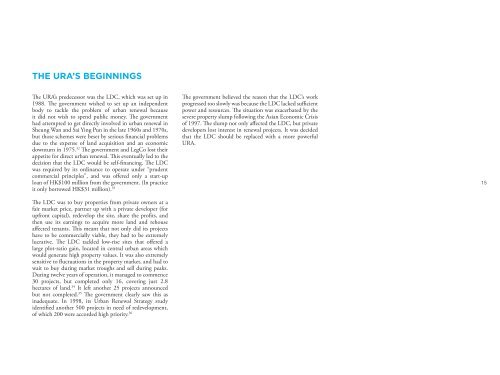Treating the Symptoms - A Critical Review of ... - Civic Exchange
Treating the Symptoms - A Critical Review of ... - Civic Exchange
Treating the Symptoms - A Critical Review of ... - Civic Exchange
- No tags were found...
You also want an ePaper? Increase the reach of your titles
YUMPU automatically turns print PDFs into web optimized ePapers that Google loves.
The URA’s BeginningsThe URA’s predecessor was <strong>the</strong> LDC, which was set up in1988. The government wished to set up an independentbody to tackle <strong>the</strong> problem <strong>of</strong> urban renewal becauseit did not wish to spend public money. The governmenthad attempted to get directly involved in urban renewal inSheung Wan and Sai Ying Pun in <strong>the</strong> late 1960s and 1970s,but those schemes were beset by serious financial problemsdue to <strong>the</strong> expense <strong>of</strong> land acquisition and an economicdownturn in 1975. 32 The government and LegCo lost <strong>the</strong>irappetite for direct urban renewal. This eventually led to <strong>the</strong>decision that <strong>the</strong> LDC would be self-financing. The LDCwas required by its ordinance to operate under “prudentcommercial principles”, and was <strong>of</strong>fered only a start-uploan <strong>of</strong> HK$100 million from <strong>the</strong> government. (In practiceit only borrowed HK$31 million). 33The LDC was to buy properties from private owners at afair market price, partner up with a private developer (forupfront capital), redevelop <strong>the</strong> site, share <strong>the</strong> pr<strong>of</strong>its, and<strong>the</strong>n use its earnings to acquire more land and rehouseaffected tenants. This meant that not only did its projectshave to be commercially viable, <strong>the</strong>y had to be extremelylucrative. The LDC tackled low-rise sites that <strong>of</strong>fered alarge plot-ratio gain, located in central urban areas whichwould generate high property values. It was also extremelysensitive to fluctuations in <strong>the</strong> property market, and had towait to buy during market troughs and sell during peaks.During twelve years <strong>of</strong> operation, it managed to commence30 projects, but completed only 16, covering just 2.8hectares <strong>of</strong> land. 34 It left ano<strong>the</strong>r 25 projects announcedbut not completed. 35 The government clearly saw this asinadequate. In 1998, its Urban Renewal Strategy studyidentified ano<strong>the</strong>r 500 projects in need <strong>of</strong> redevelopment,<strong>of</strong> which 200 were accorded high priority. 36The government believed <strong>the</strong> reason that <strong>the</strong> LDC’s workprogressed too slowly was because <strong>the</strong> LDC lacked sufficientpower and resources. The situation was exacerbated by <strong>the</strong>severe property slump following <strong>the</strong> Asian Economic Crisis<strong>of</strong> 1997. The slump not only affected <strong>the</strong> LDC, but privatedevelopers lost interest in renewal projects. It was decidedthat <strong>the</strong> LDC should be replaced with a more powerfulURA.15
















